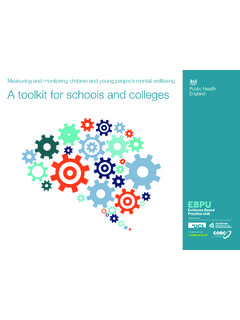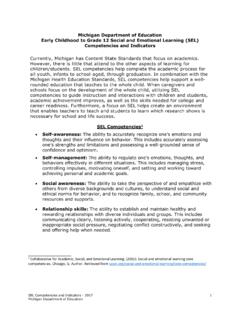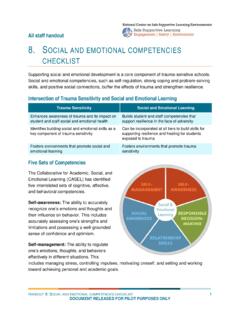Transcription of What works in promoting social and emotional well-being ...
1 What works in promoting social and emotional well -being and responding to mental health problems in schools?Advice for Schools and Framework DocumentProfessor Katherine WeareINTRODUCTIONThis advice covers two overlapping areas of school practice: promoting positive social and emotional well -being for all in schools, and tackling the mental health problems of pupils in more serious difficulty. It is designed to support schools, in particular, school leaders, in the delivery of their work on these two areas and complements other recent guidance from the Department for Education1 and from Public Health are taking their role in delivering a broad area of practice which is sometimes referred to as the non-cognitive side of education increasingly seriously.
2 The last 30 years has seen an exponential growth in programmes and interventions in schools under a wide range of titles. Internationally, programmes and research often use the term social and emotional learning (SEL), while some more specific terms are sometimes used particularly current are the terms character and resilience . In general, this field has been the focus of a considerable amount of evaluation, including several comprehensive reviews and meta-analyses3, including four in the UK covering all phases of schooling by the National Institute of Clinical Excellence4567. Research CentrePartnership for well -being and Mental Health in SchoolsPartnership for well -being and Mental Health in Schools (2015) 01 BENEFITS FOR SCHOOLS OF AN EVIDENCE-INFORMED APPROACHT aken together, well conducted reviews demonstrate that there is a solid group of approaches, programmes and interventions which, when well designed and implemented, show repeated and clear evidence of positive impacts on:l academic learning, motivation, and sense of commitment and connectedness with learning and with staff well -being, reduced stress, sickness and absence, improved teaching ability and pupil well -being including happiness, a sense of purpose, connectedness and meaning10.
3 L the development of the social and emotional skills and attitudes that promote learning, success, well -being and mental health, in school and throughout the prevention and reduction of mental health problems such as depression, anxiety and improving school behaviour, including reductions in low-level disruption, incidents, fights, bullying, exclusions and reductions in risky behaviour such as impulsiveness, uncontrolled anger, violence, bullying and crime, early sexual experience, alcohol and drug well -conducted review in the US summarised research on 207 social and emotional interventions, and suggested that schools with effective programmes showed an 11 per cent improvement in achievement tests, a 25 per cent improvement in social and emotional skills, and a 10 per cent decrease in classroom misbehaviour, anxiety and effect of interventions has routinely proved to be dramatically greater in higher-risk children.
4 There have been very few examples of adverse (harmful) effects and those that have been noted are fairly minor16. Throughout the UK, a wide range of approaches, interventions, programmes, materials and guidance have been tried and sometimes evaluated. Recent large-scale interventions have included Healthy/ Health promoting Schools, the Primary and Secondary social and emotional Aspects of Learning (SEAL) programmes and the Targeted Mental Health in Schools (TaMHS) programme in England. Taken together this work and accompanying evaluations have produced valuable learning of many kinds on what works .THE CHALLENGE FOR SCHOOLSS chools need to have a clear awareness of the extent and nature of mental health problems in children and young people and of their responsibility to be part of the response, not least because these problems do not go away.
5 Half of lifetime mental illness starts by the age of 1417. The statistics on mental health problems in the young are alarming: l 1 in 10 children and young people have a clinically diagnosed mental health disorder and/or emotional and behaviour problems (often the same children) and around one in seven has less severe problems that interfere with their development and learning. l Anti- social behaviour and conduct disorder affect over five per cent of children, particularly boys, while anxiety and depression affect four per cent1819. l Suicide is one of the three most common causes of death in youth and is now is rising: in 2014 there was a 43 per cent rise in the number of young people who admitted attempting suicide20, while self-harm and eating disorders are a growing problem.
6 02 Partnership for well -being and Mental Health in Schools (2015) social media and cyberbullying are increasingly suggested as part of the cause for the rise in these emotional disorders. Attachment disorder which gives rise to problems with connection, trust and relationships, may be on the rise as families increasingly fracture and fail, and more children join the care system21. Many problems are multiple and many remain undetected and untreated unless agencies such as schools take an active role. THE PURPOSE OF THIS ADVICEThis advice sets out a series of framing principles which are directly informed by the evidence from international research, systematic reviews and control trials of interventions and on national and local evaluations of recent work in schools.
7 It is designed to support school leaders and their staff to deliver well designed and implemented, interventions and approaches, drawing on the latest evidence that will impact on:l academic learning, motivation, and sense of commitment and connectedness to school ;l staff well -being, stress reduction and performance;l pupil well -being and the development of social and emotional skills; l the prevention and reduction of mental health problems, such as depression, anxiety and stress;l improving school behaviour and reductions in risky deals with two overlapping areas of central importance in schools, which need to be integrated to be effective: l social and emotional well -being refers to a state of positive mental health and wellness. It involves a sense of optimism, confidence, happiness, clarity, vitality, self-worth, achievement, having a meaning and purpose, engagement, having supportive and satisfying relationships with others and understanding oneself, and responding effectively to one s own emotions.
8 The guidance will outline proactive ways in which the school can promote emotional and social well -being of all who learn and work there - the so called universal mental health problems will be used refer to the wide range of mental health, emotional and social challenges, difficulties, conditions and illnesses that can beset both pupils and staff, including stress and burnout, anxiety, depression, attachment difficulties and behavioural problems. This guidance will outline actions that schools can take to prevent, identify and respond effectively to the mental health problems of their staff and students, the so called targeted approach. Partnership for well -being and Mental Health in Schools (2015) 03 Implement targeted programmes and interventions (including curriculum)s Ensure high-quality implementation of specific programmes and interventionss Explicitly teach social and emotional skills, attitudes and values, using well -trained and enthusiastic teachers and positive, experiential and interactive methods.
9 Integrate this learning into the mainstream processes of school lifeConnect appropriately with approaches to behaviour managements Respond wisely to difficult behaviour, both responding actively with clear consequences and also understanding its deeper roots, taking opportunities to model and teach positive alternativesImplement targeted responses and identify specialist pathwayss Provide more intense work on social and emotional skill development for pupils in difficulties, including one-to-one and group works Use specialist staff to initiate innovative and specialist programmes to ensure they are implemented authentically, then transfer responsibility to mainstream staff whenever possible, to ensure sustainability and integrations Where pupils experience difficulties, provide clear plans and pathways for help and referral, using a coherent teamwork approach, including in the involvement of outside agencies such as CAMHSENGAGE THE WHOLE COMMUNITYs Engage pupils through encouraging pupil voice, authentic involvement in learning, decision-making, and peer-led approachess Engage parents/carers and families in genuine participation, particularly those of pupils in difficulties whose families may feel blamed and stigmatisedDevelop supportive policyl Ensure that there are robust policies and practice in areas such as behaviour, anti-bullying and diversity.
10 Including tackling prejudice and stigma around mental healthPrioritise professional learning and staff developmentl Understand the risk factors to well -being, and help pupils develop the resilience to overcome adverse circumstancesl Raise staff awareness about mental health problems and the school s role in intervening earlyl Base their response on a sound understanding of child and adolescent developmentl help all pupils cope with predictable changes and transitions, and keep abreast of new challenges posed by technology. Adopt whole- school thinkingl Use a whole school approach , which ensures that all parts of the school organisation work coherently togetherl Provide a solid base of positive universal work to promote well -being and help prevent problemsl Develop a supportive school and classroom climate and ethos which builds a sense of connectedness, focus and purpose, the acceptance of emotion, respect, warm, relationships and communication and the celebration of differencel Start early with skills based programmes, preventive work, the identification of difficulties and targeted interventions.












